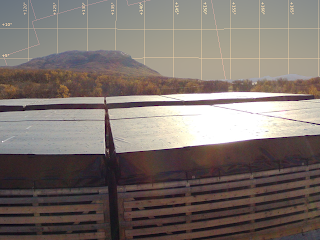There are some stunning photographs of the aurora, wildlife and the Arctic landscape these days. Better cameras, more photographers and better knowledge help. And, sure enough, the opportunities to catch those stunning moments increase. With the Internet, these are readily distributed and reach a huge audience.
Sadly, however, there are a number of altered photographs out there, which distort our perception of reality. These photographs may not be intentionally altered to deceive, but the original captions, the original context and the original audience is lost as they are circulated about the web via a plethora of social media channels.
It is only by actually having been in these places and seen these things that a few of us have the perception to recognise such alterations. Like the old depictions of lions by northern Europeans in the medieval period, they are laughable if you know what a real lion actually looks like.
But we have this with many modern Arctic photographs. Sure, the quality of the alteration is sophisticated, but many who do not know better see this as reality... which it is not.
Allow me to give an example.
In the last week or so, there have been a very popular image doing the rounds of a polar bear in front of the aurora. Of course, the world has been "ooooh" and "aaaahh" and "what a beautiful photograph". Here is the first version that I saw, posted by Animal Planet (@MeetAnimals on Twitter)...
 |
| Posted on Twitter by @MeetAnimals 26-Dec-2013 |
As an astronomer/geophysicist working in the Arctic, I'm used to seeing the northern lights. I also have done some astrophotography (both as an amateur and professionally). What immediately struck me about the image was the contrast in the lighting and the implied exposure-time requirements. Something didn't look right.
Because the Earth rotates, the sky appears to move. To get the stars to appear as pin-pricks, you need a relatively short focal-length on the camera, or you need to have a tracking platform, or you need a really big lens which has huge light-gathering power. The lens for the star field was definitely wide-angle, as you can see part of Ursa Major at the top and the bright star Alpha Boötes (above and to the left of the bear's head). This puts the vertical field-of-view at about 60 degrees. At a quick guess, I'd estimate that would be a 28mm to 35mm lens. That's a fairly wide-angle lens.
So, to the bear...
For a wide angle lens, the bear doesn't seem right. It looks too "flat", meaning that it was taken with a long focal length telephoto lens. Not surprising... given that it is a bear! Then there is the exposure. The lighting levels are not consistent with what I know real aurora to look like. The diffuse "grey" light implies a uniform white light... probably an overcast day or similar.
Given the diffusion of the aurora, this would be a fairly long exposure to get those intensities. That also matches up with the star images. In fact, you you look carefully, there are stars down to Mag. 6.5... for example I can make out HIP 67103. This is below naked-eye visibility. The bear would have to be still for quite a while there.
While the photograph was not impossible (I could contrive a lens/lighting combination that might result in something like that), it seems HIGHLY unlikely. Too unlikely.
I was suspicious.
So, I started trying to find the original. What I wanted to know was the where/when that the photo was taken. Was it in the right place? Did the star patterns match? And... most importantly, what was the camera and lens? Knowing that would help clinch whether this was good photography or good photoshop.
Then, during my search, I found this...
 |
| Found via Internet search. |
Same bear, but mirror image. And a different sky-scape. This one looks even more unlikely, in terms of exposure inconsistency, but the presence of the first image clinches it.
These are not real.
I checked the
original site and, it most clearly states in the fine print that:
DIGITAL COMPOSITE: Aurora borealis swirls across the sky over a polar
bear standing on a rock on the tundra. (composite of two images)
... which is great! They are making it quite clear that this is a composite image, which is perfectly valid. That's art, after all.
So, the problem is in the "chinese whispers" that saw the image propagate across the Internet. With each step, it becomes more and more removed from the original and people start taking it at face value to the point where some are talking about nominating it for "photograph of the year".
By no means should one consider composites as problematic. But what is disturbing, is that those who propagate it fail to mention (or do not even know) that it is such an image. The result is a distorted perception of reality in the minds of many who do not have the background or experience to recognise it for what it is. This is a harmless example, but there are implications...
When you know a topic and you see the way that it is portrayed across the media (meaning Internet and other communication channels), you begin to wonder how thin and shallow must all the other things be that we see there and take for granted. Every news report. Every article. Every web post.
The key cornerstone of science is not facts or knowledge, but critical thinking. Questioning and checking. Not knowing, but wanting to find out. And taking nothing at face value, but verifying. When we at least know something, we are given the tool to recognise things and know where to direct our interrogation.
In the meantime, we need to be wary...
... there are a lot of polar bears out there!
References
- Image 1 -- http://photos.alaskaphotographics.com/
- Image 2 -- http://photos.alaskaphotographics.com/


















































